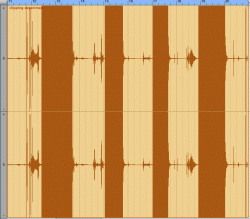...want to record everything with ultra low levels. Say that I record all my tracks, drums, guitar, vocals, whatever with levels on the firepod that aren't going past the 12 o clock position or even lower. The levels meter doesn't specify really where I am though I guess. You can see in the attachment that the dial goes from 0 - 60 and -10 - +30.
Anyway, I have been trying to record everything as hot as possible like people (ahem, douchebags) have told me to. Generally this has meant somewhere around the 3 o clock position.
Say I just skip this whole idea and start recording everything at like 9 or 11 0r 12 o clock, I never would get any clipping at these levels for sure.
Consequently though the RMS level of my rough unedited mix will be super low right? I was reading in "The Loudness Wars," a fine wikipedia article, that today's RMS level peak at around -5db here and there. And now I suppose that my rough unedited mix could and up being around -50 - -30 RMS.
That's fine. I could get my mix I see that it should be without ever worrying about clipping in the least I suppose. I could just turn my monitors up to max and till be working with a low level recording. This is fine AS LONG as I can get someone to bring the volume up in mastering so as to be competitive with commercial releases.
Are there any negatives to recording at low volumes though. Like when hiking up the signal in mastering am I going to get some kind of hum or noise or anything?
And, just to be sure, recording at low volumes doesn't mean that any details of the performance will be lost does it?
Thanks guys!!! I suppose that if all this is possible then I will join y'alls cult of low-volume sissy recording, just kidding.
just kidding.
Anyway, I have been trying to record everything as hot as possible like people (ahem, douchebags) have told me to. Generally this has meant somewhere around the 3 o clock position.
Say I just skip this whole idea and start recording everything at like 9 or 11 0r 12 o clock, I never would get any clipping at these levels for sure.
Consequently though the RMS level of my rough unedited mix will be super low right? I was reading in "The Loudness Wars," a fine wikipedia article, that today's RMS level peak at around -5db here and there. And now I suppose that my rough unedited mix could and up being around -50 - -30 RMS.
That's fine. I could get my mix I see that it should be without ever worrying about clipping in the least I suppose. I could just turn my monitors up to max and till be working with a low level recording. This is fine AS LONG as I can get someone to bring the volume up in mastering so as to be competitive with commercial releases.
Are there any negatives to recording at low volumes though. Like when hiking up the signal in mastering am I going to get some kind of hum or noise or anything?
And, just to be sure, recording at low volumes doesn't mean that any details of the performance will be lost does it?
Thanks guys!!! I suppose that if all this is possible then I will join y'alls cult of low-volume sissy recording,



